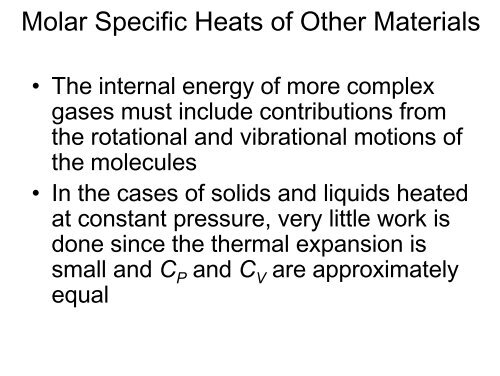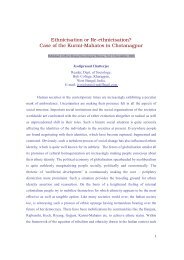Lecture 24 - WebRing
Lecture 24 - WebRing
Lecture 24 - WebRing
Create successful ePaper yourself
Turn your PDF publications into a flip-book with our unique Google optimized e-Paper software.
Molar Specific Heats of Other Materials<br />
• The internal energy of more complex<br />
gases must include contributions from<br />
the rotational and vibrational motions of<br />
the molecules<br />
• In the cases of solids and liquids heated<br />
at constant pressure, very little work is<br />
done since the thermal expansion is<br />
small and C P and C V are approximately<br />
equal
A Microscopic Description of Temperature<br />
• Simplifying the equation relating<br />
temperature and kinetic energy gives<br />
• This can be applied to each direction,<br />
with similar expressions for v y and v z
A Microscopic Description of Temperature<br />
• Each translational degree of freedom<br />
contributes an equal amount to the energy<br />
of the gas<br />
– In general, a degree of freedom refers to an<br />
independent means by which a molecule can<br />
possess energy<br />
• A generalization of this result is called the<br />
theorem of equipartition of energy
Theorem of Equipartition of Energy<br />
• Each degree of freedom contributes<br />
1/2k B T to the energy of a system, where<br />
possible degrees of freedom in addition to<br />
those associated with translation arise<br />
from rotation and vibration of molecules<br />
The total number of “types of motion” per<br />
molecule consisting of n atoms is equal 3n
Total Kinetic Energy<br />
• The total kinetic energy is just N times the kinetic<br />
energy of each molecule<br />
• If we have a gas with only translational energy,<br />
this is the internal energy of the gas<br />
• This tells us that the internal energy of an ideal<br />
gas depends only on the temperature
Equipartition of Energy<br />
• With complex<br />
molecules, other<br />
contributions to internal<br />
energy must be taken<br />
into account<br />
• One possible energy is<br />
the translational motion<br />
of the center of mass
Equipartition of Energy<br />
• Rotational motion<br />
about each of the<br />
various axes<br />
contributes 1/2k BT to<br />
the energy of a<br />
system<br />
– We can neglect the<br />
rotation around the y<br />
axis since it is negligible<br />
compared to the x and z<br />
axes
Equipartition of Energy<br />
• The molecule can also<br />
vibrate<br />
• There is kinetic energy<br />
and potential energy<br />
associated with the<br />
vibrations<br />
• Each of them is<br />
contributing 1/2k B T<br />
to the energy of a system,<br />
so total per one vibration<br />
is k B T
Water vibrations and rotations<br />
http://www.lsbu.ac.uk/water/vibrat.html
Values of Molar Specific Heats
Equipartition of Energy: Diatomic molecule<br />
• The translational motion adds three degrees of<br />
freedom<br />
• The rotational motion adds two degrees of<br />
freedom<br />
• The vibrational motion adds two more degrees<br />
of freedom<br />
• Therefore, E int = 7/2 nRT and C V = 7/2 R
Agreement with Experiment<br />
Molar specific heat is<br />
a function of<br />
temperature<br />
At low temperatures,<br />
a diatomic gas acts<br />
like a monatomic gas<br />
– C V = 3/2 R
Agreement with Experiment: H 2<br />
• At about room temperature, the value<br />
increases to C V = 5/2 R<br />
– This is consistent with adding rotational<br />
energy but not vibrational energy<br />
• At high temperatures, the value increases<br />
to C V = 7/2 R<br />
– This includes vibrational energy as well as<br />
rotational and translational
Complex Molecules<br />
• For molecules with more than two atoms,<br />
the vibrations are more complex<br />
• The number of degrees of freedom is larger<br />
• The more degrees of freedom available to a<br />
molecule, the more “ways” there are to<br />
store energy<br />
– This results in a higher molar specific heat
Quantization of Energy<br />
• To explain the results of the various molar<br />
specific heats, we must use some<br />
quantum mechanics<br />
– Classical mechanics is not sufficient<br />
• In quantum mechanics, the energy is<br />
proportional to the frequency of the wave<br />
representing the frequency<br />
• The energies of atoms and molecules are<br />
quantized
Quantization of Energy<br />
• This energy level<br />
diagram shows the<br />
rotational and<br />
vibrational states of a<br />
diatomic molecule<br />
• The lowest allowed<br />
state is the ground<br />
state
Quantization of Energy<br />
• The vibrational states are separated by<br />
larger energy gaps than are rotational<br />
states<br />
• At low temperatures, the energy gained<br />
during collisions is generally not enough to<br />
raise it to the first excited state of either<br />
rotation or vibration
Quantization of Energy<br />
• Even though rotation and vibration are<br />
classically allowed, they do not occur<br />
• As the temperature increases, the energy<br />
of the molecules increases<br />
• In some collisions, the molecules have<br />
enough energy to excite to the first excited<br />
state<br />
• As the temperature continues to increase,<br />
more molecules are in excited states
Quantization of Energy<br />
• At about room temperature, rotational<br />
energy is contributing fully<br />
• At about 1000 K, vibrational energy levels<br />
are reached<br />
• At about 10 000 K, vibration is contributing<br />
fully to the internal energy
Molar Specific Heat of Solids<br />
• Molar specific heats in solids also<br />
demonstrate a marked temperature<br />
dependence<br />
• Solids have molar specific heats that<br />
generally decrease in a nonlinear manner<br />
with decreasing temperature<br />
• It approaches zero as the temperature<br />
approaches absolute zero
DuLong-Petit Law<br />
• At high temperatures, the molar specific<br />
heats approach the value of 3R<br />
– This occurs above 300 K<br />
• The molar specific heat of a solid at high<br />
temperature can be explained by the<br />
equipartition theorem<br />
– Each atom of the solid has six degrees of<br />
freedom<br />
– The internal energy is 3 nRT and C v = 3 R
Molar Specific Heat of Solids,<br />
Graph<br />
• As T approaches 0,<br />
the molar specific heat<br />
approaches 0<br />
• At high temperatures,<br />
C V becomes a<br />
constant at ~3R
Boltzmann Distribution Law<br />
• The motion of molecules is extremely chaotic<br />
• Any individual molecule is colliding with others at<br />
an enormous rate<br />
– Typically at a rate of a billion times per second<br />
• We add the number density n V (E )<br />
– This is called a distribution function<br />
– It is defined so that n V (E ) dE is the number of<br />
molecules per unit volume with energy between E<br />
and E + dE
Number Density and Boltzmann<br />
Distribution Law<br />
• From statistical mechanics, the number<br />
density is n V (E ) = n o e –E /k B T<br />
• This equation is known as the Boltzmann<br />
distribution law<br />
• It states that the probability of finding the<br />
molecule in a particular energy state<br />
varies exponentially as the energy divided<br />
by k B T
Distribution of Molecular<br />
Speeds<br />
• The observed speed<br />
distribution of gas<br />
molecules in thermal<br />
equilibrium is shown<br />
at right<br />
• N V is called the<br />
Maxwell-Boltzmann<br />
speed distribution<br />
function

















